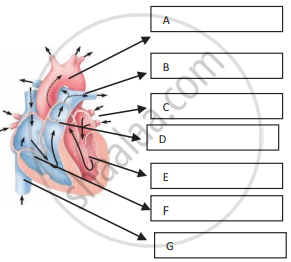Advertisements
Advertisements
प्रश्न
What is lymph? Write its function.
उत्तर
Lymph:
About 90% of the fluid that leaks from capillaries eventually seep back into the capillaries and the remaining 10% is collected and returned to the blood system by me of a series of tubules known as lymph vessels or lymphatics.
- The fluid inside the lymphatics is called lymph. The lymphatic system consists of a complex network of thin-walled ducts (lymphatic vessels), filtering bodies (lymph nodes), and a large number of lymphocytic cell concentrations in the various lymphoid organisms.
- The lymphatic vessels have smooth walls that run parallel to the blood vessels, in the skin, along the respiratory and digestive tracts. These vessels serve as return ducts for the fluids that are continually diffusing out of the blood capillaries into the body tissues.
- Lymph fluid must pass through the lymph nodes before it is returned to the blood. The lymph nodes that filter the fluid from the lymphatic vessels of the skin are highly concentrated in the neck, inguinal, axillaries, respiratory and digestive tracts.
- The lymph fluid flowing out of the lymph nodes flows into large collecting duct which finally drains into larger veins that run beneath the collar bone, the subclavian vein, and is emptied into the blood stream. The narrow passages in the lymph nodes are the sinusoids that are lined with macrophages.
- The lymph nodes successfully prevent the invading microorganisms from reaching the blood stream. Cells found in the lymphatics are the lymphocytes. Lymphocytes collected in the lymphatic fluid are carried via the arterial blood and are recycled back to the lymph. Fats are absorbed through lymph in the lacteals present in the villi of the intestinal wall.
संबंधित प्रश्न
What is the function of lymph?
Which of the following WBCs are found in more numbers?
Which of the following is not involved in blood clotting?
Lymph is colourless because ______.
Erythroblastosis foetalis is due to the destruction of ______.
Name and Label the given diagrams to show A, B, C, D, E, F, and G

Select the correct biological term.
Enable red cells to transport blood.
Select the correct biological term.
The liquid part of the blood.
Select the correct biological term.
Most of them move and change shape like an amoeba.
Select the correct biological term.
Consists of water and important dissolved substances.
Select the correct biological term.
A word that means cell eater.
Select the correct biological term.
Cells without nucleus.
Select the correct biological term.
White cells made in the lymphatic tissue.
Select the correct biological term.
Blocks wound and prevent excessive bleeding.
Select the correct biological term.
Fragment of cells which are made in the bone marrow.
Select the correct biological term.
Another name for white blood cells.
Select the correct biological term.
Slowly releases oxygen to blood cells.
Select the correct biological term.
Their function is to help blood clot in wounds.
